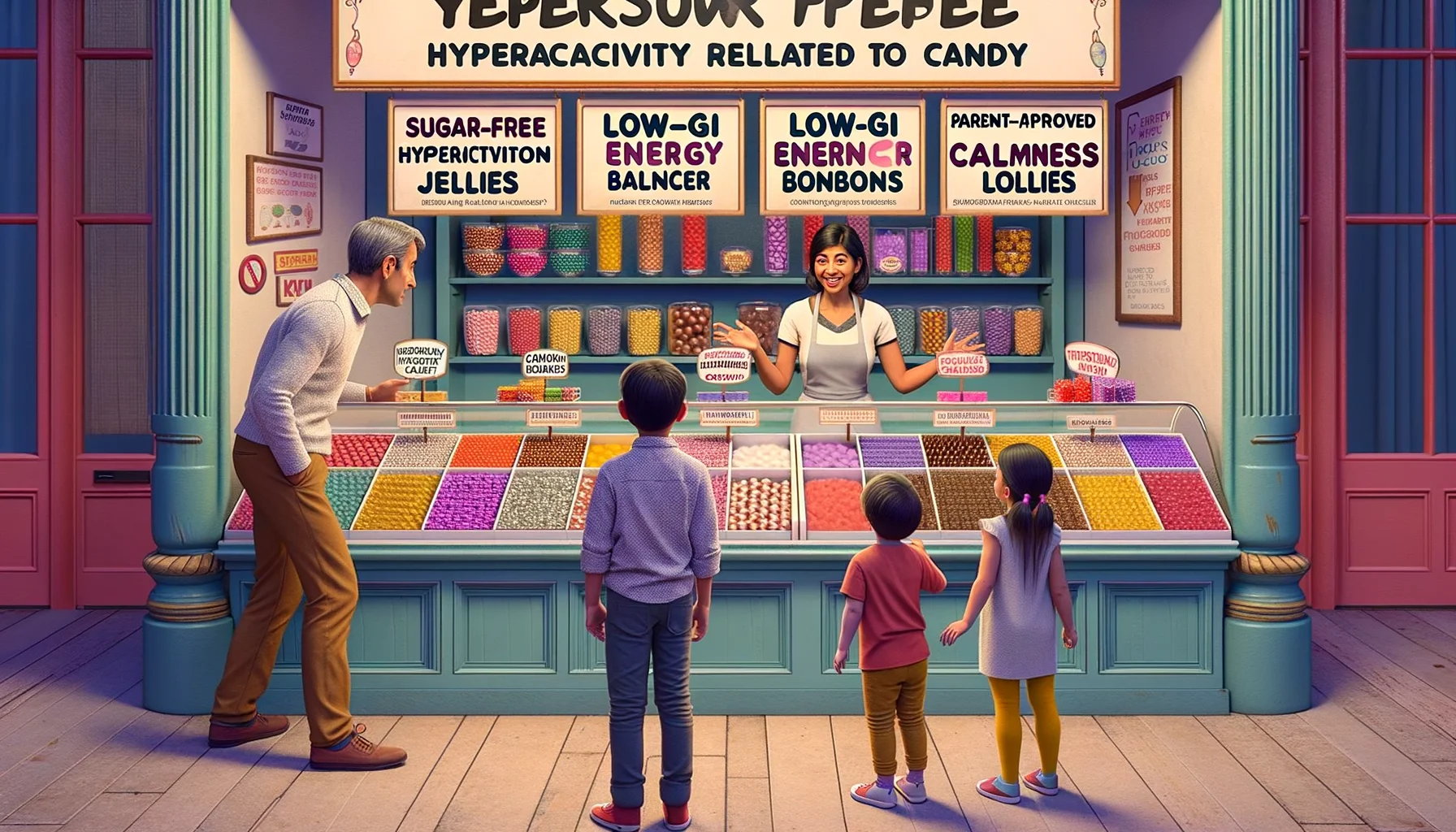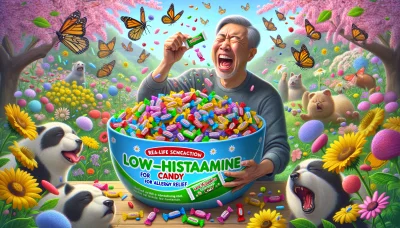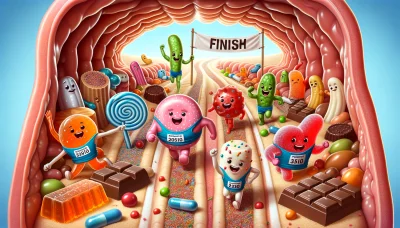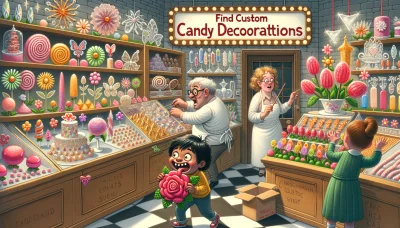Candy Options for Hyperactivity Concerns Quiz
Test Your Knowledge
Question of
Understanding Hyperactivity and Diet
When the world seems to spin a little too fast, sometimes a small sweet treat can feel like a momentary anchor, a tiny delicious pause. But for those with hyperactivity concerns or ADHD, the relationship with sweets can be a complex dance. We've all heard the cautionary tales - too much sugar and suddenly it's like you've given a squirrel a double espresso. Yet, there's something so human about craving that sugary comfort, isn't there? It's like our taste buds have their own little hearts that beat faster at the mere thought of confectionery bliss.
But let's dive into this sugar bowl with our eyes wide open. I remember the first time I learned how certain sweets could turn my niece into a whirlwind of unstoppable energy. It was as if she had tapped into some secret cosmic power source - fascinating to witness but exhausting to chase after! That's when I started to wonder: what is it about these treats that can potentially crank up the volume on hyperactivity?
Identifying Triggers in Sweets
The Role of Sugar
Ah, sugar the sweet seductress of the taste world. She beckons with a saccharine finger, promising joy and often delivering an all-too-brief high followed by the infamous crash. The role of sugar in hyperactivity has been debated back and forth, like a candy wrapper in the wind. Some studies say its guilty as charged; others suggest its just hanging around looking suspicious while other factors do the dirty work.
Personally, I recall watching my little cousin at a birthday party after he'd raided the dessert table. His laughter was infectious, his energy boundless - almost poetic in its chaos. But later came the inevitable meltdown, as if his internal battery had flipped from full to empty without warning. It made me think: Could we find balance? Could we still embrace sweetness without inviting chaos?
Artificial Additives to Avoid
Now lets talk about those sneaky artificial additives they're like ninjas hiding in our treats, often undetected until they strike. Artificial colors and flavors might make candies look and taste out of this world, but sometimes they can send sensitive individuals into orbit too. And don't get me started on preservatives - they might keep candies fresh longer than my interest in fad diets lasts, but at what cost?
I once made the mistake of giving my friends hyperactive son a candy bar loaded with more artificial colors than my entire wardrobe. The result? Let's just say he could have powered a small village with his energy output that afternoon. Lesson learned we need to be mindful of these hidden culprits lurking in our sweets.
Nutritional Alternatives to Traditional Candy
Natural Sweeteners
In my quest for balance, I've discovered natural sweeteners natures apology for creating Brussels sprouts if you will. These gems offer sweetness derived from fruits, plants, and other natural sources without waving red flags at your body's inner traffic control system. Honey, maple syrup, and stevia are like the kindly neighbors who bring over treats that are sweet but won't make you feel like you're trying to herd cats afterward.
I remember replacing my nephews usual sugar-loaded lollipops with ones sweetened with organic fruit juice. Watching him enjoy them was heartwarming; he was just as delighted, yet noticeably more grounded - like someone had turned down the volume dial on his hyperactivity stereo.
Benefits of Organic Ingredients
-
The first time I opted for organic candy over conventional options felt like I had chosen a secret passage on an old game show - one that led straight to bonus points for health and well-being.
-
Organic ingredients mean fewer pesticides and no synthetic fertilizers its like giving your body VIP treatment at an exclusive spa instead of sending it through the rough-and-tumble of a mud run.
-
I've also noticed that organic candies often have more straightforward ingredient lists something that brings peace of mind quicker than meditation apps promise serenity.
The beauty here is not just in cleaner eating but also in supporting sustainable farming practices. It feels good knowing that indulging doesnt have to mean compromising on values or well-being.
So there we are exploring candy options for those with hyperactivity concerns doesnt have to be daunting or joyless. It's quite the opposite: an adventure where each choice can bring us closer to understanding how to harmonize our love for sweets with our bodys needs for balance and health.
Selecting Hyperactivity-Friendly Candies
Have you ever felt that rush of nostalgia when unwrapping a piece of candy, the anticipation building with the crinkle of the wrapper? But then, there's a niggling thought at the back of your mind. What about the sugar rush? The hyperactivity? It's like standing at the precipice of joy and restraint. Choosing treats for those with hyperactivity concerns can be akin to finding that perfect harmony in a symphony - possible, but it requires attention to detail.
My quest for hyperactivity-friendly candies began when my nephew, who is as spirited as a whirlwind on a summer's day, was diagnosed with ADHD. I remember watching him at birthday parties, his laughter infectious but his energy levels skyrocketing after each bite of sugary confections. This is what led me to become an almost Sherlock-Holmesian figure in the candy aisles, deducing which treats would allow him to enjoy himself without turning our afternoon into a scene from a superhero movie - minus the capes.
Let me share with you what I've learned; it's not just about reducing sugar or avoiding certain dyes. It's about knowing what works for your unique child or loved one and embracing the sweet moments without fear.
Criteria for Choosing the Right Treats
Low Sugar Options
When I first embarked on this sugary journey, I was under the impression that "low sugar" was synonymous with "tasteless." Oh, how wrong I was! There's a world of flavors out there, bursting with zest and zeal, minus the high sugar content. Low sugar candies are not just about keeping hyperactivity at bay; they're also about indulging responsibly.
The key is balance. You want to find candies that have enough sweetness to satisfy that primal craving but not so much that you're bouncing off walls afterward. I've savored chocolates that whisper sweet nothings with their rich cocoa content, and hard candies that tantalize my taste buds without leaving me feeling like I've just run a marathon indoors.
Non-Stimulant Ingredients
Discovering non-stimulant ingredients was like opening Pandora's box in a good way! Who knew that chicory root or stevia could provide such delightful sweetness without sending your adrenaline into overdrive? These ingredients were game-changers. They allowed me to offer treats that didn't act as fuel to my nephew's already fiery energy levels.
- Stevia-sweetened gummies that give you that chewy satisfaction without guilt.
- Chocolates laced with natural fibers providing both texture and temperance.
- Hard candies flavored with real fruit juice Mother Natures way of saying "enjoy yourself."
Reading Labels for Hidden Hyperactivity Culprits
Deciphering Ingredient Lists
The art of deciphering ingredient lists should be taught as a class in school because its certainly an education in itself! Wading through those long, sometimes unpronounceable words can feel like you're decoding ancient hieroglyphs. But once you know what to look for, it becomes second nature.
For instance, anything ending in "-ose" is typically a sugar in disguise sneaky little devils! And then there are artificial colors and flavors; they might make candies look enticing and vibrant, but they can also be villains when it comes to hyperactivity. Learning these codes has turned me into a sort of candy detective examining each label with precision before declaring it 'safe' for consumption.
Understanding Food Labels and Certifications
Its not just about looking for 'sugar-free' or 'natural flavors' on packaging. There are certifications and labels aplenty that can guide us on our quest. For example, seeing 'certified organic' means there are no synthetic additives lurking within those colorful wrappers. And 'non-GMO' labels? They reassure us that what were consuming is as close to natures intention as possible.
I've learned to look out for specific certifications too like the Feingold Association mark, which indicates foods free from artificial flavors, colors, and preservatives known to cause hyperactive behavior in some individuals. This knowledge is empowering; it transforms us from passive consumers into informed guardians of joy and health.
In essence, selecting hyperactivity-friendly candies doesn't mean depriving ourselves or our loved ones of life's sweet pleasures. It means becoming more mindful and educated about our choices. It means allowing ourselves to indulge in delectable treats while still caring for our well-being and isn't that truly the sweetest thing of all?
Homemade Candy Solutions
Ah, the sweet symphony of sugar on the tongue it's a melody many of us know all too well. But when hyperactivity concerns dance in the shadows, indulging in that sugary chorus can turn into a cacophony. Enter the harmonious solution: homemade candy! Crafting your own confections not only allows you to compose each note with care but also brings a sense of personal achievement that makes every bite taste of triumph.
I've been there, standing in the kitchen, armed with a spatula and a dream, determined to concoct treats that wouldn't send my little nephew into overdrive. The process is almost magical mixing, shaping, and sometimes even inventing new flavors. It's like being a conductor of an orchestra where the instruments are ingredients and the music is the delightful treats you create.
DIY Recipes for Healthier Sweets
Natural Fruit-Based Candies
Picture this: vibrant strawberries, blueberries, and apples nature's candy transformed into chewy delights that burst with pure fruit essence. When I first tried my hand at making natural fruit-based candies, I was amazed at how the sweetness of ripe fruits needed so little embellishment. The beauty lies in their simplicity; a gentle simmer here, a sprinkle of citrus zest there, and voil! You've got a confectionery masterpiece that sings with natural flavors.
Every time I pop one of those gummy gems into my mouth, it's like taking a stroll through an orchard; every flavor tells a story of sunshine and soil. And let me tell you, sharing these treats with friends is like spreading little nuggets of joy they're always amazed at how something so simple can be so delicious.
Homemade Chocolate Treats with Alternative Sweeteners
There's something deeply comforting about melting chocolate its rich aroma fills the air with promises of velvety indulgence. But who says we need to stick to traditional sweeteners? My adventure with alternative sweeteners began on a whim. I was skeptical at first could honey or maple syrup really stand up to good old sugar? Well, let me spill the beans: they can and they do!
Crafting chocolate treats with alternatives like stevia or coconut sugar has been nothing short of revelatory. Each batch is an experiment that often ends in delicious surprise. Sometimes I even throw caution to the wind and add a dash of cinnamon or vanilla bean. The result? Chocolates that not only soothe the soul but also keep hyperactivity concerns at bay.
Controlling Ingredients for Hyperactivity Management
Benefits of Home Cooking
There's an undeniable charm to donning your apron and declaring yourself master of your kitchen domain. When it comes to managing hyperactivity through diet, this control is more than just charming it's empowering. By hand-selecting every ingredient that goes into your homemade candies, you're taking charge not just of flavors but also ensuring that each treat aligns with dietary needs.
It was during one such culinary crusade that I discovered how certain additives found in store-bought sweets could be contributing to my nephew's restlessness. By choosing to make our own candies at home, we were able to cut out those pesky preservatives and focus on wholesome goodness instead.
Selecting Hyperactivity-Safe Ingredients
- All-natural sweeteners like honey or agave nectar.
- Organic fruits for homemade gummies or jams.
- Dairy alternatives for creamy textures without artificial triggers.
- Cocoa powder with high flavonoid content for antioxidant benefits.
Selecting hyperactivity-safe ingredients often feels like navigating through an intricate maze; however, when you get it right, it's incredibly rewarding. For instance, opting for dark chocolate over milk chocolate provides the richness without as much sugar rush. And choosing natural dyes made from beet juice or spirulina adds color without synthetic chemicals.
Believe me when I say that seeing someone enjoy sweets without worrying about hyperactivity symptoms is like watching someone rediscover freedom. It reminds us all that life is full of flavor and zest without needing unnecessary extras.
Allergen-Free Candy Choices
Exploring Gluten and Dairy-Free Options
The quest for gluten and dairy-free candies can sometimes feel like a treasure hunt, where the spoils are as sweet as they are elusive. When I first embarked on this journey, it was a mixture of detective work and culinary exploration. I remember standing in the candy aisle, glasses perched on the bridge of my nose, reading label after label until I found those magic words: "gluten-free" and "dairy-free." It felt like a small victory each time.
These dietary restrictions don't mean we have to miss out on the joy of confections. In fact, they've led me to discover a kaleidoscope of flavors that I might have otherwise overlooked. From fruit-flavored chews that burst with tangy sweetness to rich, velvety chocolates made from rice milk, each new find is a celebration of flavor without the worry.
And let's not forget about those gummy treats! They often come to the rescue when I'm in need of something chewy and satisfying. The texture is just right not too tough, nor too soft and they come in shapes and colors that tickle the imagination as much as the taste buds.
The Connection Between Allergens and Hyperactivity
Now, you might be wondering what allergens have to do with hyperactivity. Well, I've learned that for some of us, certain food sensitivities can be like throwing fuel on a hyperactive fire. It's like there's a party happening inside your body and everyone's invited except peace and quiet.
Gluten and dairy are often culprits that can exacerbate symptoms in sensitive individuals. It's fascinating, really who would have thought that what we eat could have such an impact on how we feel and behave? But it does make sense; after all, our bodies are complex ecosystems that respond to every little thing we put into them.
So for those looking to reduce hyperactivity through diet, finding treats without these common allergens can be key. It's not just about cutting things out; it's about discovering a world of flavors that agree with you both body and mind.
Top Picks for Gluten and Dairy-Free Sweets
- Jelly Beans: These little bursts of joy come in endless varieties from classic fruit flavors to exotic spices. Just check the package to ensure they're free from gluten and dairy.
- Dark Chocolate Bars: Many dark chocolates are naturally dairy-free, offering a sophisticated twist on traditional sweets.
- Sorbet Pops: Not technically candy but when frozen fruitiness calls your name, these popsicles are a delightful alternative.
Navigating Nut-Free Candy Aisles
The Role of Colorants and Preservatives
Understanding the Impact of Artificial Colors
It's like a burst of a rainbow in every bite, isn't it? The vibrant reds, blues, and yellows that make candies so visually enticing. But have you ever stopped to think about what those colors might be doing beyond just pleasing our eyes? Artificial colors, they're like the uninvited party guests who might just be overstaying their welcome in our bodies. I remember reading somewhere that these synthetic colorants could have an impact on our behavior, maybe even playing a role in hyperactivity. It's a conversation starter at any parent gatheringhow those little treats might be affecting our little ones' energy levels.
Now, I'm no scientist, but I've heard whispers in the aisles of health food stores and snippets from parenting podcasts about the potential link between artificial colors and hyperactivity in children. It's enough to make you pause with a half-eaten jelly bean in hand. The evidence isn't conclusive yet, but it's certainly something that tickles my curiositylike trying to solve a mystery with every piece of candy as a clue.
And let's not forget ourselves in this colorful conundrum. Adults too can feel the ripples caused by these artificial hues. Ever felt a bit more 'buzzed' than usual after snacking on some brightly colored sweets? It's not just the sugar rushit might be the rainbow working its magic on you too.
Studies on Colorants and Behavior
The plot thickens with each study I come across. Some researchers seem convinced there's a link between artificial colorants and behavioral changes, while others remain skeptical, arms crossed, waiting for more proof. It reminds me of watching those detective shows where every clue adds to the suspense. One study might show an increase in hyperactivity among children consuming certain dyes, while another study waves its hand dismissively, citing insufficient evidence.
I remember stumbling upon one such investigationthe infamous Southampton Studyand feeling like I'd uncovered an ancient scroll filled with forbidden knowledge. It suggested that certain mixtures of artificial food colors and preservatives could indeed contribute to increased hyperactivity in some children. Suddenly, every candy wrapper seemed like it was hiding secrets in plain sight.
But let's not leap to conclusions; science is meticulous and demands patiencemuch like perfecting your grandmother's secret cookie recipe. More research is needed, but it does give one pause when reaching for that next technicolor treat, doesn't it?
Natural Alternatives to Synthetic Dyes
It's not all gloom and doom though! Picture this: candies colored with spices from your own kitchenturmeric yellows, beetroot reds, spirulina greensit's like a farmers' market exploded into your candy jar! These natural alternatives paint our sweets with hues derived from nature herself; it feels like going back to basics in the most delicious way possible.
I once tried these naturally colored gummies and let me tell you, it was as if my taste buds were frolicking through an enchanted garden. The flavors seemed purer somehowlike each chew was whispering sweet nothings about its wholesome origins.
And imagine this: sharing these guilt-free treats with friends or watching your kids enjoy them without that nagging worry at the back of your mind about hyperactivity or behavioral changesits like taking a deep breath after reaching the top of a mountain climb.
Preservatives to Watch Out For
Moving on from colors to something just as sneakypreservatives. They're like the secret agents of the candy world; you don't always see them, but they're there alright, working behind the scenes to keep things shelf-stable longer than nature intended. But at what cost? Some say these agents can be double-edged swords when it comes to our health and well-being.
I recall reading labels more closely these daysits become my new hobby at grocery storesand spotting names like "TBHQ" or "BHT". They sound more like robot models than food ingredients! These common preservatives are lurking around many processed foods including candies and can potentially contribute to hyperactivity concerns among sensitive individualsor so some cautious voices suggest.
Sometimes I feel like a detective piecing together clues as I navigate through aisles of sweetseach label another piece of evidence in building my case for healthier indulgence.
Common Preservatives in Candy
Lurking within the ingredient lists on candy wrappers are characters such as sodium benzoate and potassium sorbatefrequent flyers in the world of confectionery preservatives. They mingle among sugars and oils like undercover spies blending into a crowd at a masquerade ball.
- Sodium Benzoate: Often found gatecrashing sodas and fruit juices too.
- Potassium Sorbate: Likes to hang out with its buddy Sodium Benzoate quite often.
- BHT (Butylated Hydroxytoluene): A mouthful to say and apparently controversial in its effects!
Its almost comical how these ingredients sound less appetizing when theyre stripped down to their chemical titles rather than dressed up as freshness savers or flavor protectors. We've all been theresquinting at tiny texts trying to pronounce these mysterious names only to end up feeling like we're reciting an incantation rather than reading a candy label!
Preservative-Free Candy Brands
Ah, but then theres that sigh of relief when you spot those three magical words: "No Added Preservatives". Its akin to finding an oasis in a deserta beacon of hope for concerned parents and health-conscious sweet tooths alike!
I've developed quite an admiration for brands that boldly go where few have gone beforein pursuit of preservative-free candies. They're not just selling sweets; they're selling peace of mind wrapped up in pretty packages. And isn't peace of mind just another form of indulgence?
In my personal odyssey through confectionery lands far and wide (or mostly through online shopping), discovering preservative-free options has become akin to unearthing hidden treasure chests filled with goldexcept this gold is edible and wont leave you worried about any unwanted hyperactive side effects!
Portion Control and Frequency of Consumption
Establishing Healthy Eating Habits
When I think back to my childhood, the sheer excitement of unwrapping a candy bar was akin to uncovering a treasure chest. However, as the years went by, I learned that indulging in these sugary delights required a certain finessea balancing act, if you will. Establishing healthy eating habits isn't about depriving ourselves of the joy that comes from a piece of candy melting on our tongues; it's about understanding the importance of moderation.
There's a certain art to enjoying candy without letting it steer us towards hyperactivity or unhealthy patterns. Like sipping on a fine wine, savoring each bite allows us to appreciate the intricate dance of flavors without overindulging. This approach not only curbs the potential for sugar-induced energy spikes but also cultivates an appreciation for the treats we choose to enjoy.
The Importance of Moderation
Moderation is a word that often sounds like a party pooper knocking at the door. Yet, in my journey with sweets, I have found that moderation is less about restriction and more about empowerment. It's granting yourself permission to enjoy lifes sweetness while also nurturing your body with respect. Discovering this balance means you can relish in the occasional caramel chew without feeling like you've wandered off your path to well-being.
Embracing moderation also teaches us self-control, which is an empowering trait that bleeds into other areas of our lives. By managing our candy consumption, we're not just looking after our physical health; we're reinforcing discipline and mindfulnessskills that serve us well beyond the dinner table or snack drawer.
Tips for Limiting Candy Intake
- Set specific days for candy treats rather than making them an everyday occurrence.
- Use smaller plates or bowls when serving sweets to naturally reduce portion sizes.
- Combine your candy with a handful of nuts or some fruit to satiate hunger with fewer pieces.
- Store candies out of sight to avoid mindless snacking and make them a conscious choice.
As someone who once could demolish a family-sized bag of gummy bears in one sitting, I've learned that these tips aren't just effectivethey're transformative. They've helped me shift from viewing candy as a forbidden fruit to treating it as a special guest at the table of my diverse diet.
Balancing Treats with a Nutritious Diet
Integrating Sweets into a Balanced Diet
Integrating sweets into a balanced diet is like adding sprinkles to vanilla ice creamit should enhance, not overwhelm. The key here is ensuring that these sugary extras don't become the main event. For instance, following up a wholesome meal with a small treat can satisfy cravings without tipping the scales toward nutritional chaos.
Personally, I find joy in creating 'reward moments' throughout my week where I allow myself a piece of dark chocolate after achieving small goals. This practice turns candy into both celebration and motivation rather than mindless consumption. It's about crafting an intentional relationship with food that acknowledges both its nourishing and pleasurable aspects.
Encouraging Healthy Snacking Alternatives
Its easy to reach for that chocolate bar when mid-afternoon hunger pangs hittrust me, I've been there more times than I can count! But over time, I've discovered the magic in healthy snacking alternatives that are just as satisfying but wont send my energy levels on a rollercoaster ride.
Swapping out candies for snacks like yogurt parfaits topped with honey or fresh berries dipped in almond butter has been revolutionary. These alternatives offer natural sweetness paired with nutrients that keep me going strong throughout the day. And remember, it's not about eliminating treatsit's about finding creative ways to enjoy them alongside choices that fuel our bodies and minds.
Educational Resources and Support
The quest to understand the nexus between diet, hyperactivity, and the treats we love is like embarking on a gastronomic journey with a compass of curiosity. It's a path sprinkled with questions, sometimes as colorful and varied as the candies we ponder over. And it's not just about sugar highs or the crackle of a candy wrapper; it's about delving deep into the fabric that weaves our dietary choices with our well-being.
I remember sitting cross-legged on my grandmother's plush carpet, a kaleidoscope of candy spread before me like treasures. She'd tell me stories of her childhood treats, simple yet magical. But today, as we become more aware of the impact food can have on behavior, especially in children, these stories take on new layers. It's not just nostalgia; it's about arming ourselves with knowledge and understanding that what we consume can be both delightful and disciplined.
As I navigated this landscape for my own family, I found solace in educational resources that served as lighthouses in a sea of confectionery choices. It was empowering to learn from experts who had researched the sweet science behind hyperactivity concerns and could provide guidance without stripping away the joy of indulgence.
Books and Articles for Further Reading
My first steps were cautious, tiptoeing through pages that whispered secrets of nutrition and its effects on energy levels. Each book was like a friend, offering advice and anecdotes, blending scientific insights with relatable stories. These reads became my bedtime tales, each chapter a stepping stone towards making informed choices for my spirited little ones.
- Recommended Reads for Parents and Caregivers
- Informative Articles on Diet and Hyperactivity
The titles themselves seemed to beckon with promises of clarity: "The Sweet Truth: Balancing Hyperactivity & Treats", "Sugar Rushed: Unraveling Myths About Candy & Behavior", "Lollipop Logic: Navigating Nutritional Neuroscience". As I devoured their contents, each page turn was like biting into a new layer of understandingcrisp insights enveloped in chewy complexities.
Support Groups and Online Forums
But books weren't my only companions on this journey. I discovered entire communities onlineparents like me, caregivers seeking serenity in the sugar storm. We shared stories that made us laugh until our sides hurt (like the time I found my son trying to make 'healthy' candy out of broccolibless his heart). These forums became my kitchen table, where virtual strangers passed around wisdom like dishes at a potluck dinner.
- Finding Community Support
- Online Resources for Healthy Candy Choices
The support groups were more than just sounding boards; they were incubators for growth and empowerment. There were threads dedicated to 'Candy Alternatives for the Energetic Child', 'Snack-time Strategies', even 'Mindful Munching'. Each post felt like an invitation to join hands and embark on this confectionery quest togetherfinding balance one treat at a time.











